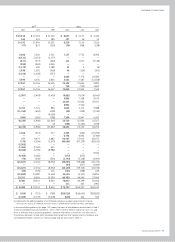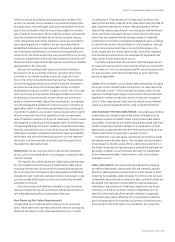GE 2011 Annual Report Download - page 86
Download and view the complete annual report
Please find page 86 of the 2011 GE annual report below. You can navigate through the pages in the report by either clicking on the pages listed below, or by using the keyword search tool below to find specific information within the annual report.84 GE 2011 ANNUAL REPORT
based on discounted cash fl ow estimates which refl ect current
and projected lease profi les and available industry information
about capitalization rates and expected trends in rents and occu-
pancy and are corroborated by external appraisals. These
investments are generally included in Level 3.
RETAINED INVESTMENTS IN FORMERLY CONSOLIDATED
SUBSIDIARIES.
Upon a change in control that results in deconsoli-
dation of a subsidiary, the fair value measurement of our retained
noncontrolling stake in the former subsidiary is valued using an
income approach, a market approach, or a combination of both
approaches as appropriate. In applying these methodologies, we
rely on a number of factors, including actual operating results,
future business plans, economic projections, market observable
pricing multiples of similar businesses and comparable transac-
tions, and possible control premium. These investments are
included in Level 1 or Level 3, as appropriate, determined at the
time of the transaction.
Accounting Changes
On January 1, 2011, we adopted Financial Accounting Standards
Board (FASB) ASU 2009-13 and ASU 2009-14, amendments to
ASC 605, Revenue Recognition and ASC 985, Software, respec-
tively, (ASU 2009-13 & 14). ASU 2009-13 requires the allocation of
consideration to separate components of an arrangement based
on the relative selling price of each component. ASU 2009-14
requires certain software-enabled products to be accounted for
under the general accounting standards for multiple component
arrangements. These amendments are effective for new revenue
arrangements entered into or materially modifi ed on or subse-
quent to January 1, 2011.
Although the adoption of these amendments eliminated the
allocation of consideration using residual values, which was
applied primarily in our Healthcare segment, the overall impact of
adoption was insignifi cant to our fi nancial statements. In addition,
there are no signifi cant changes to the number of components or
the pattern and timing of revenue recognition following adoption.
On July 1, 2011, we adopted FASB ASU 2011-02, an amend-
ment to ASC 310, Receivables. ASU 2011-02 provides guidance
for determining whether a restructuring of a debt constitutes a
TDR. ASU 2011-02 requires that a restructuring be classifi ed as a
TDR when it is both a concession and the debtor is experiencing
fi nancial diffi culties. The amendment also clarifi es the guidance
on a creditor’s evaluation of whether it has granted a concession.
The amendment applies to restructurings that have occurred
subsequent to January 1, 2011. As a result of adopting these
amendments on July 1, 2011, we have classifi ed an additional
$271 million of fi nancing receivables as TDRs and have recorded
an increase of $77 million to our allowance for losses on fi nancing
receivables. See Note 23.
On January 1, 2010, we adopted ASU 2009-16 and ASU
2009-17, amendments to ASC 860, Transfers and Servicing, and
ASC 810, Consolidation, respectively (ASU 2009-16 & 17). ASU
2009-16 eliminated the Qualifi ed Special Purpose Entity (QSPE)
concept, and ASU 2009-17 required that all such entities be evalu-
ated for consolidation as VIEs. Adoption of these amendments
resulted in the consolidation of all of our sponsored QSPEs. In
addition, we consolidated assets of VIEs related to direct invest-
ments in entities that hold loans and fi xed income securities, a
media joint venture and a small number of companies to which
we have extended loans in the ordinary course of business and
subsequently were subject to a TDR.
We consolidated the assets and liabilities of these entities at
amounts at which they would have been reported in our fi nancial
statements had we always consolidated them. We also decon-
solidated certain entities where we did not meet the defi nition
of the primary benefi ciary under the revised guidance; however,
the effect was insignifi cant at January 1, 2010. The incremen-
tal effect on total assets and liabilities, net of our investment in
these entities, was an increase of $31,097 million and $33,042 mil-
lion, respectively, at January 1, 2010. The net reduction of total
equity (including noncontrolling interests) was $1,945 million at
January 1, 2010, principally related to the reversal of previously
recognized securitization gains as a cumulative effect adjustment
to retained earnings. See Note 24 for additional information.
We adopted amendments to ASC 320, Investments—Debt and
Equity Securities, and recorded a cumulative effect adjustment to
increase retained earnings as of April 1, 2009, of $62 million.
























